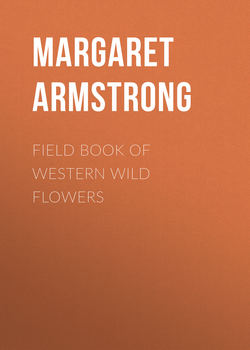Читать книгу Field Book of Western Wild Flowers - Armstrong Margaret - Страница 1
PREFACE
ОглавлениеIn this little book a very large number of the commoner wild flowers growing in the United States, west of the Rocky Mountains, are pictured and described. It is the first attempt to supply a popular field book for the whole West. The field is vast, including within its limits all sorts of climate and soil, producing thousands of flowers, infinite in variety and wonderful in beauty, their environment often as different as that of Heine's Pine and Palm. In such strange homes as the Grand Canyon and the Petrified Forest of Arizona, or the deserts of Utah and southern California, we find the oddest desert plants, forced to curious expedients in order to sustain life amidst almost perpetual heat and drought, but often displaying blossoms of such brilliance and delicacy that they might well be envied by their more fortunate sisters, flourishing beside shady waterfalls, in a "happy valley" like Yosemite, or a splendid mountain garden, such as spreads in many-colored parterres of bloom around the feet of Mt. Rainier. On the wind-swept plains hundreds of flowers are to be found; many kinds of hardy plants brighten the salty margins of the sea cliffs, or bloom at the edge of the snow on rocky mountain peaks, while quantities of humble, everyday flowers border our country roadsides or tint the hills and meadows with lavish color.
The field included the States of Washington, Oregon, California, Idaho, Nevada, Utah, and Arizona and to designate this whole field the term West is used in this book. The term Northwest designates Washington, Oregon, northern Idaho, and northern California, and the term Southwest covers southern California and Arizona. The flowers found only in the Rocky Mountains are not included, and it may be noted here that exceedingly few of the western flowers cross the Rockies and are found in the East.
This is the only fully illustrated book of western flowers, except Miss Parsons's charming book, which is for California only. The drawings have all been made from life. Allowance must be made for differences in appearance, owing to locality, and the text should be consulted for the size, as, on so small a page, some of the plants must be drawn smaller than others.
Almost all technical botanical terms have been translated into ordinary English, as this book is intended primarily for the general public, but as a large number of the plants given have never before been illustrated, or even described, except in somewhat inaccessible or technical publications, it is hoped that the scientist also may find the contents both interesting and useful.
The nomenclature used, with few exceptions, is that of the American Code. Where these names differ greatly from those in common usage the latter are given as synonyms in brackets, making the book more useful to all readers. The botanical names are marked with an accent. Two accents are used, the grave (`) to indicate the long English sound of the vowel, such as the "i" in "violet," and the acute (´) to show the short sound, such as the "i" in "lily."
Professor J. J. Thornber, of the University of Arizona, is responsible for the botanical accuracy of the text and his knowledge and patient skill have made the book possible.
Thanks are due for most valuable assistance in the determination of a very large number of specimens to Miss Alice Eastwood, of the California Academy of Sciences. Also to Dr. W. L. Jepson of the University of California; Professor A. O. Garrett, of Salt Lake City; Professor A. R. Sweetser, of the University of Oregon; Mr. S. B. Parish, of San Bernardino, Cal.; Mrs. Henshaw, of Vancouver, B. C.; Dr. A. Davidson, of Los Angeles; and Mr. Marcus E. Jones, of Salt Lake City. Also for advice and assistance to Dr. N. L. Britton, and Dr. H. M. Richards of New York; to Dr. Livingston Farrand, of Colorado; Mr. C. R. Orcutt, of San Diego; Mr. Carl Purdy, of Ukiah, Cal.; Professor Flett, of Mt. Rainier National Park; Miss Winona Bailey, of Seattle; Professor J. H. Paul, of Salt Lake City; and many other kind friends.
The arrangement is that originated by Mr. Schuyler Mathews, in his Field Book of American Wild Flowers, which has been found very popular in the East, but, in this book, most of the genera, as well as the species, have been very briefly described.
Margaret Armstrong.
New York,
January 1, 1915.
